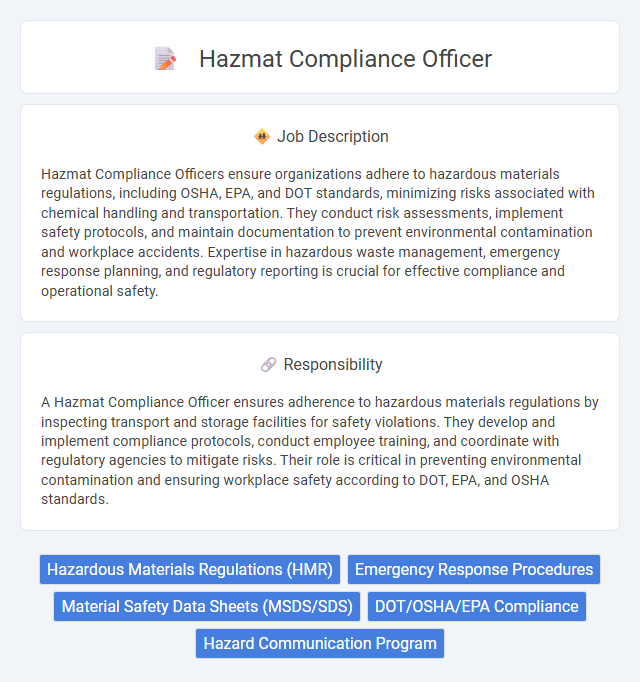
Hazmat Compliance Officers ensure organizations adhere to hazardous materials regulations, including OSHA, EPA, and DOT standards, minimizing risks associated with chemical handling and transportation. They conduct risk assessments, implement safety protocols, and maintain documentation to prevent environmental contamination and workplace accidents. Expertise in hazardous waste management, emergency response planning, and regulatory reporting is crucial for effective compliance and operational safety.
Individuals who demonstrate strong attention to detail, adherence to safety protocols, and the ability to remain calm under pressure are likely to be suitable for a Hazmat Compliance Officer role. People with a preference for structured environments and a commitment to regulatory compliance may find this position aligns well with their skills and temperament. Conversely, those uncomfortable with strict guidelines or high-stress situations might not thrive in this job.
Qualification
A Hazmat Compliance Officer must possess a thorough understanding of hazardous materials regulations, including OSHA, DOT, and EPA standards. Key qualifications include a background in environmental science, safety management, or related fields, along with certifications such as Hazardous Materials Technician or OSHA HAZWOPER. Strong analytical skills and experience in risk assessment and emergency response planning are essential for effective compliance enforcement.
Responsibility
A Hazmat Compliance Officer ensures adherence to hazardous materials regulations by inspecting transport and storage facilities for safety violations. They develop and implement compliance protocols, conduct employee training, and coordinate with regulatory agencies to mitigate risks. Their role is critical in preventing environmental contamination and ensuring workplace safety according to DOT, EPA, and OSHA standards.
Benefit
A Hazmat Compliance Officer likely ensures that hazardous materials are handled and stored according to safety regulations, reducing the risk of accidents and legal penalties. This role probably offers substantial benefits such as enhanced workplace safety, regulatory adherence, and potential cost savings for companies. Jobholders may also experience professional growth opportunities due to the specialized knowledge required in hazardous materials management.
Challenge
Hazmat Compliance Officers likely face complex challenges in ensuring strict adherence to hazardous materials regulations, which constantly evolve and vary by jurisdiction. They probably encounter difficulty balancing operational efficiency with rigorous safety protocols to prevent accidents and environmental harm. Managing potential regulatory violations and coordinating emergency responses may require high attention to detail and proactive problem-solving skills.
Career Advancement
A Hazmat Compliance Officer ensures adherence to hazardous materials regulations to prevent safety violations and environmental hazards. Mastery of regulatory frameworks such as OSHA, DOT, and EPA standards enables career advancement into senior compliance roles or safety management positions. Progression often includes specialized certifications like Certified Hazardous Materials Manager (CHMM) and opportunities in risk assessment, training development, and corporate safety leadership.
Key Terms
Hazardous Materials Regulations (HMR)
Hazmat Compliance Officers ensure adherence to the Hazardous Materials Regulations (HMR) established by the Pipeline and Hazardous Materials Safety Administration (PHMSA) to guarantee safe transportation, storage, and handling of hazardous materials. They conduct audits, train personnel, and implement policies to maintain regulatory compliance and minimize risks associated with hazardous substances. Expertise in HMR requirements, including packaging, labeling, and documentation, is essential for mitigating legal liabilities and enhancing workplace safety.
Emergency Response Procedures
A Hazmat Compliance Officer specializes in developing and enforcing emergency response procedures to manage hazardous material incidents safely and efficiently. They conduct risk assessments, coordinate with emergency teams, and ensure adherence to OSHA, EPA, and DOT regulations. Effective emergency response planning minimizes environmental impact and protects human health during hazardous spills or exposures.
Material Safety Data Sheets (MSDS/SDS)
A Hazmat Compliance Officer ensures strict adherence to regulations involving hazardous materials by maintaining accurate and up-to-date Material Safety Data Sheets (MSDS) or Safety Data Sheets (SDS). These documents provide critical information on chemical properties, handling procedures, and emergency measures, essential for workplace safety and regulatory compliance. Proper management of MSDS/SDS facilitates risk assessment, employee training, and incident response, minimizing environmental and health hazards.
DOT/OSHA/EPA Compliance
Hazmat Compliance Officers ensure strict adherence to Department of Transportation (DOT), Occupational Safety and Health Administration (OSHA), and Environmental Protection Agency (EPA) regulations for the safe handling, storage, and transportation of hazardous materials. They conduct thorough inspections, develop compliance programs, and provide employee training to mitigate risks and prevent violations. Expertise in regulatory frameworks and detailed record-keeping is essential for maintaining workplace safety and avoiding federal penalties.
Hazard Communication Program
The Hazmat Compliance Officer ensures strict adherence to Hazard Communication Program standards, managing the proper labeling, documentation, and employee training for hazardous materials. This role involves maintaining Safety Data Sheets (SDS) and verifying that all hazardous chemicals are correctly stored and handled according to OSHA and EPA regulations. Proficiency in risk assessment and regulatory updates is essential to minimize workplace hazards and ensure legal compliance.
 kuljobs.com
kuljobs.com